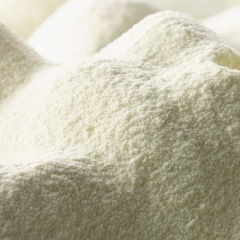Difference between revisions of "Milk, dried"
| Line 21: | Line 21: | ||
Improper ventilation can result in the paper bags attracting moisture. This causes mould, the smell of which can filter through the packing making its contents unfit for consumption. Mould may also spring from the spillage of milk-powder (from torn bags) which attracts the moisture of the environment. Despite good packaging, taint from mould can penetrate into the contents of undamaged bags. Mould can also develop on floors and structures when the relative humidity in the container is high. In cases of severe mould it might lead to fumigation being required. Milk-powder being "odour-sensitive cargo", should in principle be stowed by itself and only after careful consideration should it be joint packed with another commodity.<br><br> | Improper ventilation can result in the paper bags attracting moisture. This causes mould, the smell of which can filter through the packing making its contents unfit for consumption. Mould may also spring from the spillage of milk-powder (from torn bags) which attracts the moisture of the environment. Despite good packaging, taint from mould can penetrate into the contents of undamaged bags. Mould can also develop on floors and structures when the relative humidity in the container is high. In cases of severe mould it might lead to fumigation being required. Milk-powder being "odour-sensitive cargo", should in principle be stowed by itself and only after careful consideration should it be joint packed with another commodity.<br><br> | ||
See [[Canned Goods]] for stowage instructions. | See [[Canned Goods]] for stowage instructions. | ||
| + | |||
| + | [[Category: Products]] | ||
| + | [[Category: Food and beverages]] | ||
Latest revision as of 14:40, 15 April 2013
| Infobox on Milk, dried | |
|---|---|
| Example of Milk, dried |  |
| Facts | |
| Origin | - |
| Stowage factor (in m3/t) | 2,12 m3/t |
| Humidity / moisture | See text |
| Ventilation | See text |
| Risk factors | See text |
Milk, dried
Description
Powdered milk or dried milk is a manufactured dairy product made by evaporating milk to dryness. One purpose of drying milk is to preserve it; milk powder has a far longer shelf life than liquid milk and does not need to be refrigerated, due to its low moisture content. Another purpose is to reduce its bulk for economy of transportation. Powdered milk and dairy products include such items as dry whole milk, nonfat dry milk, dry buttermilk, dry whey products and dry dairy blends. Many dairy products exported conform to standards laid out in Codex Alimentarius.
Powdered milk is used for food and health (nutrition), and atypically also in biotechnology (saturating agent).
Application
Powdered milk is frequently used in the manufacture of infant formula, confectionery such as chocolate and caramel candy, and in recipes for baked goods where adding liquid milk would render the product too thin. Powdered milk is also widely used in various sweets such as the famous Indian milk balls known as Rasgulla and popular Indian sweet delicacy (sprinkled with desiccated coconut) known as Chum chum (made with skim milk powder).
Powdered milk is also a common item in UN food aid supplies, fallout shelters, warehouses, and wherever fresh milk is not a viable option. It is widely used in many developing countries because of reduced transport and storage costs (reduced bulk and weight, no refrigerated vehicles). As with other dry foods, it is considered nonperishable, and is favoured by survivalists, hikers, and others requiring nonperishable, easy-to-prepare food.
Due to its resemblance to cocaine and other drugs, powdered milk is sometimes used in filmmaking as a non-toxic prop that may be inhaled.
Shipment / Storage / Risk factors
Shipped in tins, inside cases, cartons and multiwall paper bags. Storage in a moist atmosphere may give rise to mould growth. Rancidity, caking and bacterial development may be indicative of exposure to air. Milk powder also absorbs moisture, and this may give rise to these conditions.
Losses occur from bursting of containers solely by reason of their inability to hold the weight of the contents; for example, milk powder in 25 kg tins usually carries well, but when shipped in 50 kg tins, usually two tins to the case, handling in transit frequently causes the bursting of the tins, even though the cases are externally in good order and condition. Wetting of multiwall bags may reduce support for plastic lining and lead to subsequent loss by bursting.
The highest standard of container cleanliness is required and for New Zealand an inspector of the N.Z. Dairy Board will inspect the container. Because of the hygroscopic nature of milk powder, the Dairy Board packaging consists of multiwall paper bags with one or more polyethylene linings.
Improper ventilation can result in the paper bags attracting moisture. This causes mould, the smell of which can filter through the packing making its contents unfit for consumption. Mould may also spring from the spillage of milk-powder (from torn bags) which attracts the moisture of the environment. Despite good packaging, taint from mould can penetrate into the contents of undamaged bags. Mould can also develop on floors and structures when the relative humidity in the container is high. In cases of severe mould it might lead to fumigation being required. Milk-powder being "odour-sensitive cargo", should in principle be stowed by itself and only after careful consideration should it be joint packed with another commodity.
See Canned Goods for stowage instructions.











